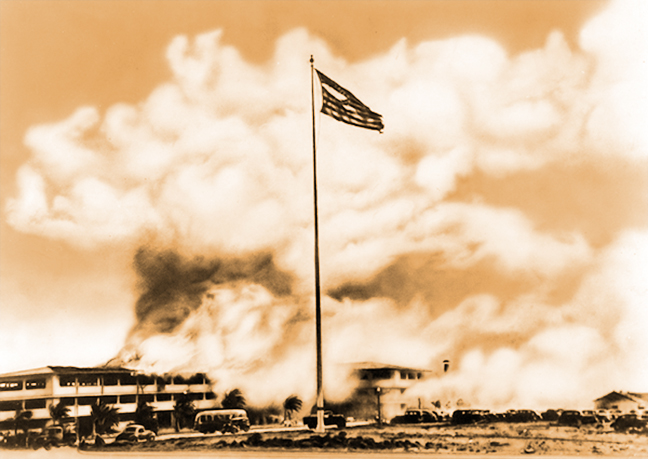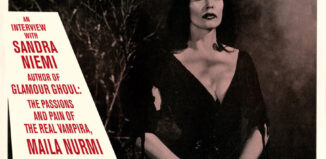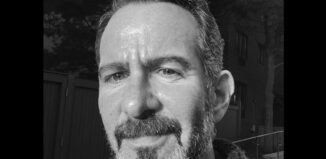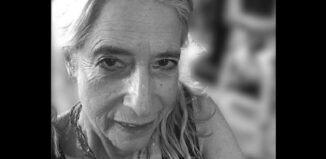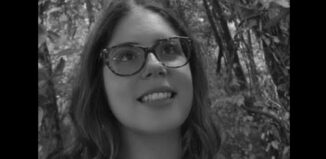The Blitz
by Liz Gilmore Williams
As a . . . Pearl Harbor survivor, I am often asked what ship I was on. When I reply that I wasn’t on a ship
but was stationed at Hickam Field, I am usually asked, “Where is Hickam Field?” The Japanese certainly knew!
―Master Sgt. Thomas J. Pillion
On December 7, 1941, Ernest Galeassi, a private in the Army Air Corps’ 324th Signal Company based at Oahu’s Hickam Field, got up, shaved, dressed, and went to mass, then to the chow hall for breakfast. He walked back to the barracks and sat down on its front steps, looking across the airfield. He soon spied planes almost grazing the barracks’ roof, planes marked with the red rising sun of Japan, dubbed the “meatball,” by the GIs. As the planes zoomed overhead, Galeassi yelled inside to those in the barracks, “We’re being attacked!” He ran two blocks to the motor pool as an ear-splitting boom sounded from Pearl Harbor, the first target. Black smoke billowed over the naval base. Hickam’s air raid siren blared.
While Galeassi sprinted to the motor pool to move the company’s trucks under some palm trees, my dad, Herb Gilmore, worked teletype in Hickam’s Bomber Command Signal Office in the Base Operations building―the centrally located nerve center of the base. He relayed new developments from one headquarters to another and sent and took orders for the Commanding Generals. Only his helmet and the building protected him. Outside, dive bombers whined, machine-gun fire chattered, and bombs thundered.
A lineman truck driver in Herb’s company, Private Thomas J. Pillion, and another signalman drove a truck full of field wire, telephones, and other equipment to Base Ops. Japanese bombs hit the hangar line and hangars, whistling past Pillion and his colleague, Bill Kokosko, as they arrived at Base Ops and huddled under a palm tree. The smell of gunpowder filled their nostrils.
Lt. Col. Guy N. Church, the ranking Signal Officer, drove up in his staff car and got out with his arms full of sporting guns. He handed Pillion and Kokosko each a shotgun but no ammunition. They left the guns at the message center. As they exited Base Ops, Japanese planes splintered the Hawaiian Air Depot, hangars, and hangar line. Pillion and Kokosko ducked under the building where a grating had been removed. Minutes later, they headed to their company’s supply building. Meanwhile, Air Corps gunners manned the parade ground―without cover―and got mowed down like blades of grass, to be replaced by more gunners.
The bombing stopped for about 30 minutes. Ambulances began picking up the wounded. Then the bombers returned, blasting Hickam for another 15 minutes. This time, some Japanese planes exploded from anti-aircraft fire. Every time an enemy plane blew up, everyone stood up and cheered as if at a baseball game. The enemy hammered supply buildings, the base chapel, Snake Ranch, and guard house.* The sparkling, new consolidated barracks shook repeatedly with the force of the explosions, which splattered food, trays, and the bodies of men in the chow hall. Almost all of the 100 Japanese bombs dropped on Hickam hit a target. Reportedly the most heavily bombed building on Oahu, the consolidated barracks burned for four hours. Bodies lay everywhere.
Though at first some men at Hickam wandered about, panic stricken, most took heart and fought back, firing .50-caliber machine guns, Thompson submachine guns, Colt .45s automatic pistols, and even World War I-era bolt-action Springfield rifles. They may as well have thrown their guns at the bombers. Thirty-five AAF planes took flight, some engaging the enemy and others in pursuit, unaware the Japanese had already left the area. Hawaiian Air Force fighter pilot and heir to the grape juice fortune, George S. Welch, shot down 4 of the 29 enemy planes destroyed that day, the first American to down a Japanese plane.
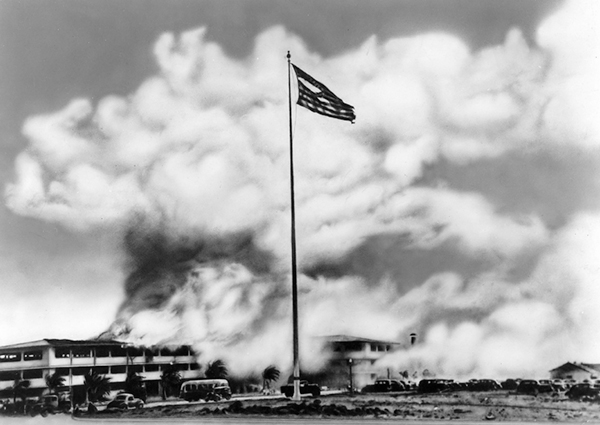
This iconic photo shows Hickam’s brand-new barracks in flames after the Japanese attack. The truck at the base of the flag pole belongs to Herb’s company, members of which were fixing a damaged cable. The tattered flag in the photo later flew above the United Nations charter meeting in San Francisco, over the Big Three conference at Potsdam, and above the White House on August 14, 1945, when the Japanese surrendered. (Signal Corps photo from Herb’s collection)
Pillion and his buddies spent most of the day running field wire and supplying field telephones to bomb squads and headquarters groups. At night, the cratered parade ground and burning vehicles made passage almost impossible when Pillion and another signalman, Jim Bagot, drove back to Base Ops. At midnight, the air raid siren wailed. Spotlights beamed on more planes overhead, U.S. Navy planes. Everyone with a weapon shot at them. The sky lit with red hot tracers, Pillion and Bagot dove for shelter under Base Ops. Feeling secure, they laughed, probably from nerves, and lit cigarettes. “Sgt. Herbert Gilmore” told them to put out the smokes. “Go to hell,” they replied.
Like Herb, men from all signal companies at Hickam stayed at their posts to radio, teletype, or phone messages at a moment’s notice during the attack. The switchboard operators handled thousands of calls every hour. Linemen repaired severed or damaged lines. Those who stayed on duty in the Base Ops building, like Herb, should have received medals of recognition but did not, according to Pillion’s oral history of the attack: “Everyone in the company performed the duties for which they were trained without question. I was proud to have served in the 324th Signal Company.”
Oahu suffered horrifying carnage and wreckage: more than 2,300 men died and 1,100 were wounded. AAF posts on Oahu lost more than 200 men, with 700 wounded. Though Hickam lost 121 men, with 274 wounded and 37 missing, the attack claimed no lives in Herb’s company. Of the Hawaiian Air Force’s 146 planes, 76 were lost; an additional 128 army planes were damaged island-wide. Forty explosions had rocked Honolulu, all but one the result of U.S. anti-aircraft fire. Honolulu lost 48 civilians, 3 fire fighters, and 4 government employees.
During the attack, known in Hawaii as the “Blitz,” untried troops responded as veterans. Silver stars and purple hearts decorated the chests of 233 men at Hickam afterwards.
I looked through one of my father’s scrapbooks to see if any of his buddies had been cited. There, among their poems, messages, and names and home addresses, I found two signatures of awardees in Daddy’s company: Joseph P. Miszczuk, of Nanticoke, Pennsylvania, and John S. Lopinsky, of Summerlee, West Virginia. Lopinsky, an outstanding baseball player for the Hawaiian Air Force, played on a volleyball team with my father.
The night of the Blitz, critical units headed for wooded areas beyond the base, on 24-hour alert. The bomber command moved to its forward post, which it used until the next day. Herb’s company sent enough signalmen along with the command to maintain 24-hour communications.
Like disaster evacuees, Hickam’s men found shelter under trees or blankets that night or in pup tents, unlocked family quarters, or wherever they could sleep. Under a moonlit sky, a blackout cloaked all light on the ground to help thwart an invasion. Neighborhood wardens patrolled to see that residents shut off lights and covered windows with black cloth; those who failed to do so could be arrested.
Frenetic activity took place immediately after the Blitz. All important buildings in Hawaii received a coat of camouflage paint, including Hickam’s beautiful water tower, and Honolulu’s Aloha Tower, then the tallest structure in Hawaii. The military convinced 200 or so “lei women” to weave camouflage nets instead of leis. To prevent Japanese landings, the military strung barbed wire along the beaches. All paper money in the Territory was recalled and burned to prevent the misuse of U.S. currency if Hawaii was captured. As in World War I, people began planting vegetable gardens of eggplants, lettuce, carrots, sweet potatoes, and onions. Children started toting gas masks everywhere they went.
The military convinced the governor of Hawaii to declare martial law. The authorities arrested civilians, including 370 Japanese, 98 Germans, and 14 Italians, to prevent them from aiding the enemy. Martial law remained in effect for three years. Like grounded teenagers, the once light-hearted islands succumbed to curfews, rationing, and endless regulations.
Herb, like many Americans, viewed Japan’s unannounced attack as sneaky. As the United States declared war on Japan on December 8, 1941, Americans rallied―none more than the airmen, soldiers, sailors, and marines on Oahu. They wanted revenge.
*The Snake Ranch, so named because “You walked in but crawled out” was the enlisted men’s beer hall.
BIO
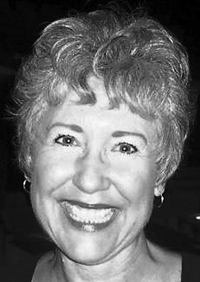 Liz Gilmore Williams worked as a writer and editor for more than 20 years in Washington, D.C., for two agencies of the U.S. Congress, a trade association, and a few consulting firms. Her essay, “April Love,” won an Honorable Mention award for creative nonfiction in the Virginia Writers Club’s “Summer Shorts” Contest for 2014 and was published by the Indiana Voice Journal in February 2015. Her essay, “The Last Time,” published by the Wilderness Literary Review in January 2015, was the most read piece in that online issue. Both essays and her story “The Blitz” derive from her book, No Ordinary Soldier: Discovering Daddy in My Parents’ Letters from World War II, for which she is seeking representation. She received an MA in American studies from the University of Maryland and belongs to the South Carolina Writers Workshop and the Charlotte Writers Club.
Liz Gilmore Williams worked as a writer and editor for more than 20 years in Washington, D.C., for two agencies of the U.S. Congress, a trade association, and a few consulting firms. Her essay, “April Love,” won an Honorable Mention award for creative nonfiction in the Virginia Writers Club’s “Summer Shorts” Contest for 2014 and was published by the Indiana Voice Journal in February 2015. Her essay, “The Last Time,” published by the Wilderness Literary Review in January 2015, was the most read piece in that online issue. Both essays and her story “The Blitz” derive from her book, No Ordinary Soldier: Discovering Daddy in My Parents’ Letters from World War II, for which she is seeking representation. She received an MA in American studies from the University of Maryland and belongs to the South Carolina Writers Workshop and the Charlotte Writers Club.
Twitter: @warletterlover
Website: www.warlettersfromwwii.com/

